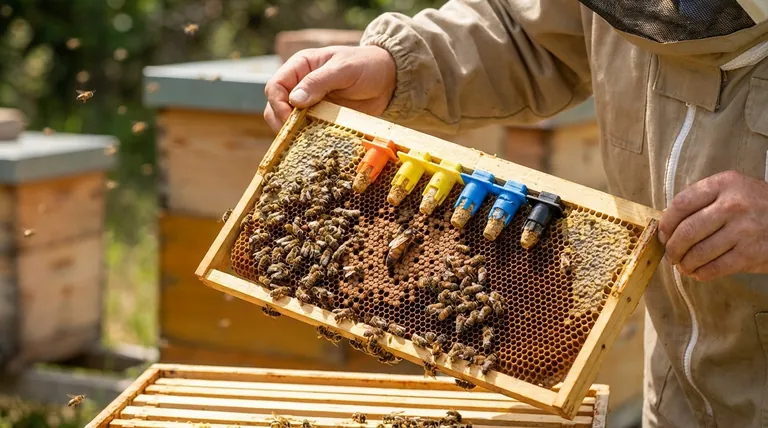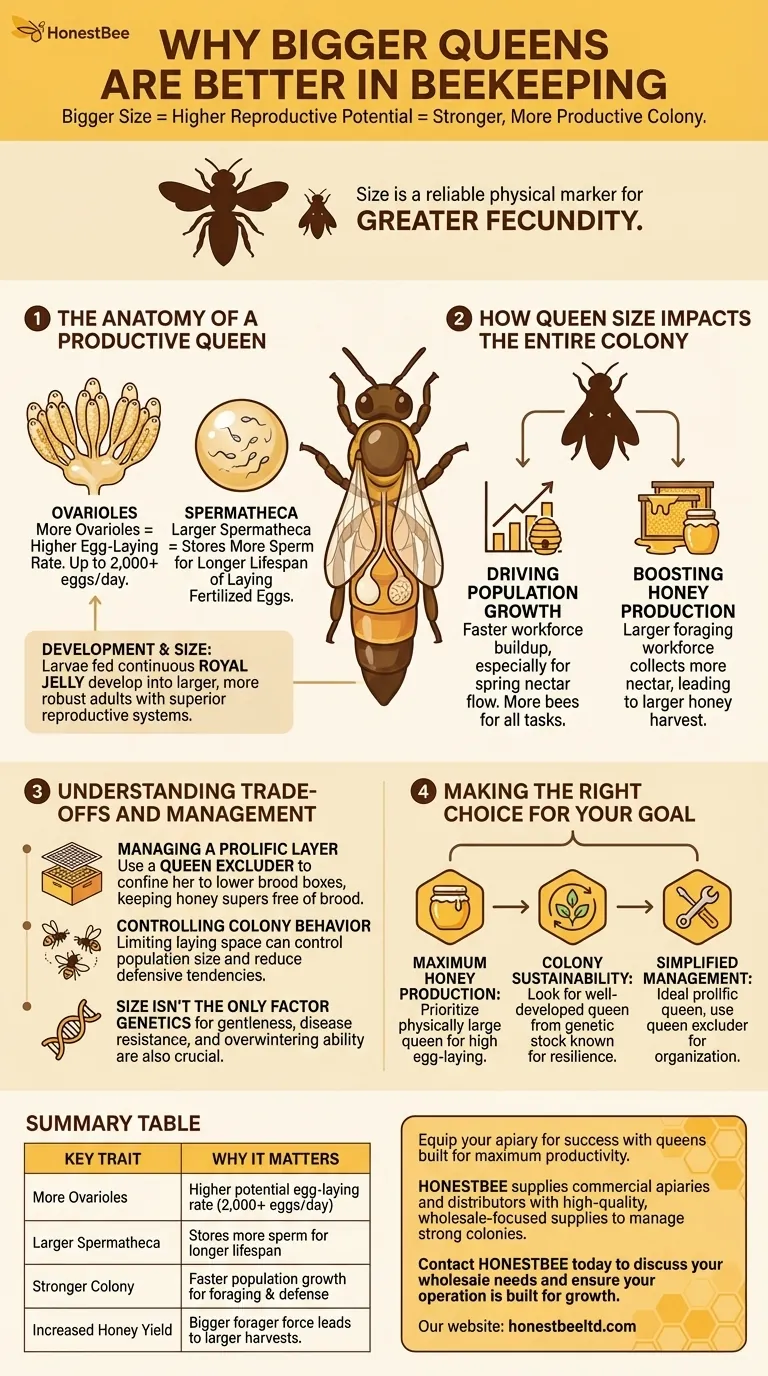In beekeeping, a bigger queen is considered better because her size is a direct indicator of her reproductive potential. A queen bee's primary role is to lay eggs, and her physical dimensions, particularly her abdomen, correlate directly with the capacity of her internal reproductive organs. This allows her to lay more eggs over a longer lifespan, which is the fundamental driver of a strong and productive colony.
The core takeaway is that a queen's size is not an aesthetic preference but a reliable physical marker for greater fecundity. A larger body houses a more developed reproductive system, enabling her to lay the vast number of eggs required to build and sustain a powerful, resilient, and productive honey bee colony.

The Anatomy of a Productive Queen
A queen's value is measured by her ability to populate a hive. Her physical size is the most visible sign of the internal "machinery" that makes this possible.
The Role of Ovarioles
A queen's ovaries are composed of dozens of individual egg-producing tubes called ovarioles. A larger, better-developed queen simply has more of them.
More ovarioles directly translate to a higher potential egg-laying rate. This is how top-tier queens can lay over 2,000 eggs per day—a mass equivalent to their own body weight.
The Importance of the Spermatheca
The spermatheca is a vital organ where the queen stores all the sperm she will ever collect during her mating flights.
A larger queen typically has a larger spermatheca. This allows her to store more sperm from a greater number of drones, ensuring she can lay fertilized (female) eggs for several years without exhausting her supply.
The Link Between Development and Size
Queen size is not determined by genetics alone; it is heavily influenced by her development as a larva.
A larva destined to become a queen is fed a continuous, rich diet of royal jelly. Larvae that receive more copious amounts of this food develop into larger, more robust adults with superior reproductive systems.
How Queen Size Impacts the Entire Colony
A highly fecund queen doesn't just lay more eggs; she fundamentally transforms the dynamics and potential of her hive.
Driving Population Growth
A high egg-laying rate is the engine of colony population. A bigger queen can build up the hive's workforce much faster, especially during the critical spring nectar flow.
More worker bees mean more bees to perform all essential tasks: foraging for nectar, tending to brood, defending the hive, and building comb.
Boosting Honey Production
The single biggest factor in a colony's honey surplus is the size of its foraging workforce.
A large population, built by a prolific queen, can field an army of foragers to collect nectar far beyond what the colony needs for its own survival, resulting in a larger honey harvest for the beekeeper.
Understanding the Trade-offs and Management
While a large queen is highly desirable, her productivity creates specific management considerations for the beekeeper.
Managing a Prolific Layer
A queen laying at full capacity can quickly fill the hive with brood, sometimes leaving little room for honey in the main brood boxes.
To manage this, beekeepers often use a queen excluder. This device confines the queen to the lower brood boxes, ensuring the upper boxes (honey supers) are used exclusively for honey storage and remain free of brood.
Controlling Colony Behavior
In some regions, particularly those with Africanized bees, limiting a queen's laying space with an excluder can help control population size and reduce the colony's defensive tendencies.
This practice may also help in managing pests like varroa mites by concentrating the brood into a smaller, more manageable area of the hive.
Size Isn't the Only Factor
While size is a critical indicator of egg-laying potential, it is not the only trait of a good queen.
Genetics for other characteristics, such as gentleness, disease resistance (e.g., hygienic behavior), and overwintering ability, are equally important for the long-term success and manageability of a colony.
Making the Right Choice for Your Goal
Selecting a queen should align with your primary objective as a beekeeper. Her physical characteristics are a strong clue to her potential performance.
- If your primary focus is maximum honey production: Prioritize a physically large queen, as this is the best indicator of the high egg-laying rate needed for a massive foraging workforce.
- If your primary focus is colony sustainability: Look for a well-developed queen from a genetic stock known for good hygienic behavior and resilience, not just size alone.
- If your primary focus is simplified hive management: A large, prolific queen is ideal, but be prepared to use tools like a queen excluder to direct her laying and keep the brood nest organized.
Ultimately, selecting a well-developed, large queen is an investment in the fundamental engine of your colony's success.
Summary Table:
| Key Trait | Why It Matters for a Larger Queen |
|---|---|
| More Ovarioles | Enables a higher potential egg-laying rate (e.g., 2,000+ eggs/day). |
| Larger Spermatheca | Stores more sperm for a longer lifespan of laying fertilized eggs. |
| Stronger Colony | Faster population growth builds a larger workforce for foraging and defense. |
| Increased Honey Yield | A bigger forager force collects more nectar, leading to larger harvests. |
Equip your apiary for success with queens built for maximum productivity. A prolific queen is the engine of your hive, but she needs the right equipment to thrive. HONESTBEE supplies commercial apiaries and beekeeping equipment distributors with the high-quality, wholesale-focused supplies needed to manage strong colonies effectively—from durable hive bodies and frames to essential tools like queen excluders.
Contact HONESTBEE today to discuss your wholesale needs and ensure your operation is built for growth.
Visual Guide

Related Products
- JZBZ Langstroth Queen Rearing Frame for Beekeeping
- Double Head Beekeeping Grafting Tools for Beekeepers
- Plastic Chinese Queen Grafting Tool for Bee Queen Rearing
- Plastic Queen Bee Catcher Marker Tube Holder for Queen Marking Bottle
- 4 Frame Plastic Nuc Boxes for Beekeeping Bee Nuc Box
People Also Ask
- What do queen rearers do with queens that fail to lay on time? The Critical Quality Control Decision
- How do you prepare the frame for the Queen Rearing kit? Boost Queen Acceptance & Larval Quality
- What are the developmental periods for different bee castes? Master the 16, 21, and 24-Day Timelines for Hive Success
- Why is it difficult to purchase queens during the production season? The Seasonal Demand Spike Explained
- What are orientation flights for virgin queens? The Essential Guide to Queen Bee Navigation



















